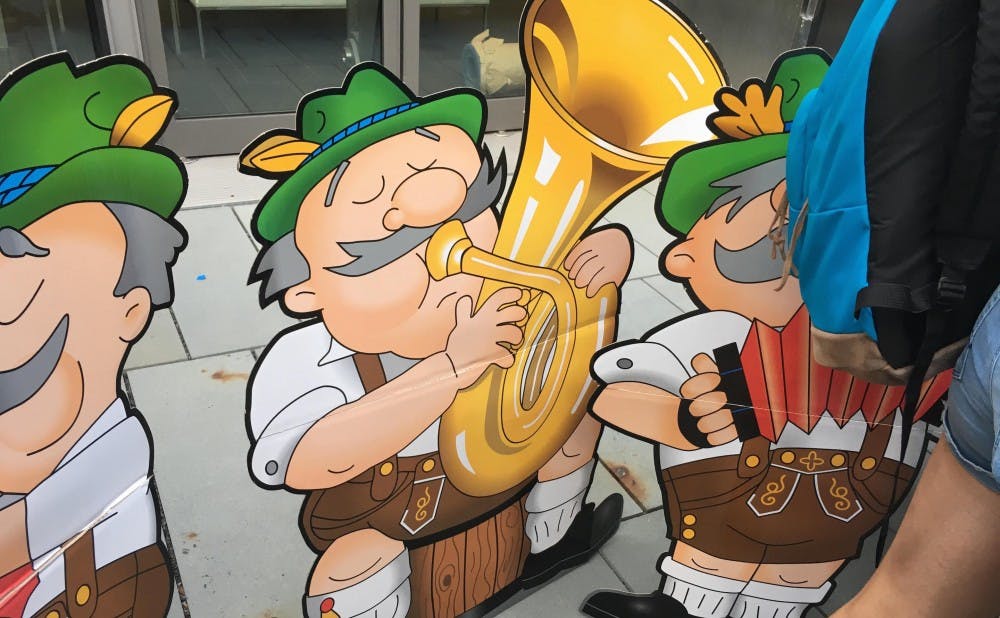The patio outside Au Bon Pain is usually populated by busy students eager to finish their homework or by hungry ones who prefer the natural air to the AC’s constant blast inside. On Friday, however, the area became home to a dazzling crowd celebrating Oktoberfest, a traditional German holiday held annually at the beginning of fall.
Organized by Duke University Union, the Oktoberfest featured German classics like Bratwurst, a special kind of sausage, soft pretzels with salt, Obazda, a mixture of cheese and butter, and of course, copious amounts of beer. The patio was decorated with draperies in blue and white, the official colors of Bavaria, the south-German state that is home to Oktoberfest. Cardboard cutouts of men in Lederhosen (leather pants) and women in Dirndl (customary dresses) were arranged next to the long buffet, making for a somewhat comical, but also adorable atmosphere.
Not long after the official 5:30 p.m. start, a long line started form across the area, ranging all the way up the stairs to the Bryan Center Plaza — a feat similar to the notoriously endless lines in front of German nightclubs. The first 100 students had been promised a free Oktoberfest beanie, which explains the many early-birds the event drew.
Music was provided by modern, local groups as well as by the Asheville-based Mountain Top Polka Band. Founded in 2010, the band specializes in Southeast German music and performs at events in North Carolina and neighboring states. Its repertoire includes traditional tunes with accompanying English lyrics, as well as folk songs like “Der Vogelbeerbaum” or “Das Kufsteiner Lied,” which are not only sung in German, but use specific rural dialects.

Since the drinking age in Germany is 16 for beer, Duke was forced to make some changes to the ubiquitous culture of alcohol consumption that characterizes most festivals of this kind. Beer was only served in an enclosed area labeled “Beer Garden,” where students had to present a valid I.D. before they were allowed entrance. In an effort to curb underage drinking, strict security was in place.
Although German is a common language studied at Duke, most academic accounts of Germany focus either on the country’s rich cultural history in the fields of music, literature and philosophy, or on its current position as Europe’s strongest economic power. The Duke Oktoberfest was a welcome addition to this, as it showcased the more jovial and colloquial aspects of central Europe that often go unnoticed in purely historical analyses. Obviously, the large beer tents and overwhelming mass of inebriated people that characterize the original Munich Oktoberfest could not be recreated, but the jolly and talkative atmosphere created on the patio resembled the famous vibe on a smaller scale.
Originally conceived as a celebration of Prince Ludwig’s marriage with Princess Luise Therese of Saxe-Hildburghausen in 1810, Oktoberfest is now the world’s biggest beer festival, drawing around 6 million visitors per year to the Theresienwiese in Munich, the capital of Bavaria. It is traditionally opened by the mayor of Munich, who taps the first keg and then hands the festival’s first beer to the Bavarian prime minister, who serves a position like that of a governor in the United States.
Although its primary attraction is indeed the beer served in “Maß,” glasses that hold 34 fluid ounces (1 liter), there are also copious food trucks and amusement rides for sober entertainment.
Inquiring about the Duke event’s authenticity may, however, be the wrong question to ask.
“Well, not too much,” said Fiona Danner, a visiting student from Berlin’s Humboldt University who grew up in Bavaria. She said that neither the potato salad served nor the pretzels were close to their European counterparts, but she still commended the picture booth and the joyful mood everybody seemed to be in.
“They did try their best given what America sells as German food, which is slim to none,” added Max Gardner, a junior who previously studied in Germany as part of the Duke in Berlin program. Apart from intensively studying the language, he had explored the country’s food scene, its avid soccer fans and the many cultural attractions that its capital has to offer.

Both Danner and Gardner noted that hot dog buns, like those served along with the sausages at Duke, are unheard of in Germany, where a special kind of breakfast roll called “Brötchen” is the go-to side on such occasions.
In spite of all limitations, the event was a pleasant introduction to Germany's celebratory culture and a great change to the dreary first week after fall break, in which many students return to their studious selves after the recreational activities they enjoyed over break. Those in search of drunken hordes may have been better off at Shooters or at the numerous fraternity parties, but the event certainly gave students a taste of its Bavarian counterpart. No matter if students will experience their next Oktoberfest in Germany or at Duke, pretzels and sausages are guaranteed at either location.
Get The Chronicle straight to your inbox
Sign up for our weekly newsletter. Cancel at any time.

